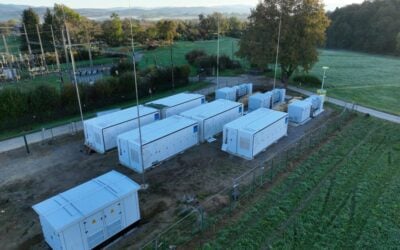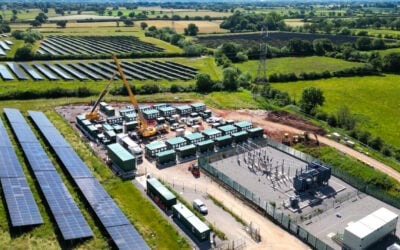A view of how the UK Houses of Parliament would look if sea levels continue to rise. Image: Climate Central.
The UK government's Department of Energy and Climate Change (DECC) is seeking answers from the energy storage industry on how best to define and consider the various technologies, both behind and in front of the meter.
A DECC official confirmed the department will issue a Call for Evidence from the energy storage industry, at the annual meeting of the Electricity Storage Network yesterday.
Enjoy 12 months of exclusive analysis
- Regular insight and analysis of the industry’s biggest developments
- In-depth interviews with the industry’s leading figures
- Annual digital subscription to the PV Tech Power journal
- Discounts on Solar Media’s portfolio of events, in-person and virtual
Or continue reading this article for free
The ESN, which looks primarily at grid-scale storage and network issues, advocates for the installation of 2000MW of electricity storage capacity on the UK network by 2020. Danae Marshall from DECC and Rory McCarthy of regulator Ofgem attended the event in London, which many would-be developers of UK large-scale battery projects also attended.
DECC’s Marshall said yesterday that her department is opening a Call for Evidence in Spring, which in government parlance could mean as late as May, with the DECC response to that consultation then expected to appear in autumn.
However, National Grid is seeking to tender 200MW of grid-scale storage projects to provide frequency response to the network - balancing electricity supply and demand to keep the grid running at a frequency of 50Hz, which is essential for its stable operation. National Grid is targeting having projects for this tender completed and connected by the end of the third quarter of 2017.
The Electricity Storage Network - and others - have also been advocating that, while the industry is not interested or does not need subsidies, it requires a clear definition from DECC and Ofgem as to the role it can play, both for individual system owners, and for the wider network. While the majority of topics covered at yesterday’s event were regarding “in front of the meter”, grid-scale batteries, both DECC and Ofgem are seeking evidence on energy storage at all scales. According to DECC’s Danae Marshall, the Call For Evidence will include “everything” and could also cover related technologies such as hot water tanks.
According to ESN’s Dr Jill Cainey, as batteries and other large-scale technologies could take up to 12 months to deploy, under current arrangements project developers will have to go ahead with frequency response projects later this year without clarity and may find financing their projects more difficult, despite there clearly being investor appetite for the technologies.
Danae Marshall also stressed the difference between a consultation and a Call For Evidence (CFE), in that a call does not customarily allow for advocacy of one approach over another. This means it could be a lengthy process before DECC formulates its own position.
Marshall made it very clear that DECC’s examination of storage is at a very early stage and admitted that as yet, the department “does not have any clear answers”.
However, Ofgem’s Rory McCarthy said as the regulator has much more flexibility than DECC to put forward one position or another and would also be seeking input and opinions from the industry. Meanwhile the newly-formed National Infrastructure Commission is also calling for evidence to put together longer term plans for the UK.
At a recent event held by the UK Renewable Energy Association, several speakers reiterated a long held view that as the storage industry is asking for clear definitions and categorisations that would enable a market, rather than asking for subsidies to support one, the government should be broadly in favour of the technologies, which while offering the opportunity to help decarbonisation efforts by allowing for more renewables to be deployed, could also benefit the network at lower cost than, for example, the building and upgrading of substations and other infrastructure.
Interim measures
ESN says that some interim measures could be put in place to allow electricity storage to get off the ground. This could include Ofgem issuing a standard special license condition. Longer term, ESN is asking for energy storage licenses to be issued, with exemptions for smaller-scale systems, covering the fact that storage can act in network terms as a generator, as load and as part of the transmission and distribution system.
Behind the meter storage is customer-sited, meaning it refers to storage where deployed for the individual system user’s benefit, such as time-shifting solar energy for use when the sun is not shining, whereas in front of the meter storage is deployed at transmission or distribution level to provide network services, such as frequency response and other ancillary services, or to lower peak demand.
Some models are being trialled globally to aggregate smaller-scale systems which act behind the meter and simultaneously provide front of the meter network services. In the UK, one company, Moixa Technology is already trialling this ‘dual use’ of behind the meter storage by connecting together around 300 residential and small commercial systems.
The UK’s grid-balancing enhanced frequency response (EFR) tender through National Grid has drawn great interest from both UK and overseas companies. These include Renewable Energy Systems (RES), which has carried out frequency regulation projects in the US already and NEC ES.
Commenting on the EFR tender, NEC ES’ Roger Lin said it could be one of the most “lucrative markets for energy storage in the world”, with another 600MW of future procurement possible after the initial 200MW tender.
Energy Storage News and our publisher, Solar Media, will be hosting the Energy Storage Summit this year at Twickenham Rugby Stadium, England on 28 April.






